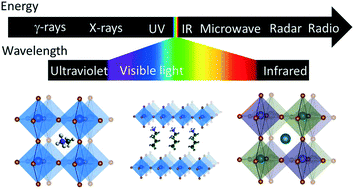Molecular engineering of perovskite photodetectors: recent advances in materials and devices
Abstract
Organic–inorganic hybrid perovskites have attracted tremendous attention due to the unprecedented success in the field of photovoltaics over the past few years. With a deeper understanding of their opto-electronic properties and the elucidation of the materials' structure–property relationships, perovskites and their composites used in other platforms have been increasingly reported, including in light emitting diodes, lasers, photodetectors, memory devices etc. In this review, we present the current status and recent advances in photodetectors based on perovskites and perovskite composites and discuss the molecular engineering of perovskite systems introduced in photodetection. This review mainly covers (i) the modulation of the fundamental properties via molecular design and mastering the materials' composition, (ii) miniaturization and functionalization, (iii) the spectral tunability of perovskite photodetectors and (iv) hard radiation detection. All these achievements and recent progress in device performance are correlated with the materials' versatility and the tunability of properties. We also point out the open challenges facing perovskite photodetectors for manufacturing and real-world applications, followed by future directions which are promising to explore and require more research efforts.

- This article is part of the themed collections: MSDE most-read Q1 2019, 2018 MSDE Hot Articles and Perovskite Based Optoelectronics: Molecular Design Perspectives


 Please wait while we load your content...
Please wait while we load your content...